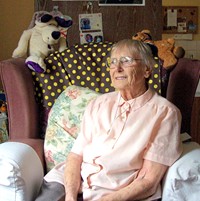|
Life in the laundry
AT ST PETER'S HOSPITAL
by DOROTHY HODGKIN
|
 |
It was 1950
and I had just got married but we needed some extra money because we
planned to start a family and so I got a job in the laundry. My husband,
Reginald, was employed as a farm worker, and we lived in a tied cottage at
Toft and this meant a six-mile cycle ride to and from the hospital every
day, whatever the weather. My hours were 8 am until 5 pm Monday to Friday
for a wage of £2 10s. a week and the work was hard and monotonous.
The laundry had recently been modernised and was full of giant washing
machines and tumble driers although all of the ironing was still done by
hand. The items which came in consisted of bed linen and clothing from the
staff and inmates at St Peter's which then had about fifty patients.
These were all women, aged from twenty upwards, the older patients having
been there for many years but not all of them were employed in the laundry
and those who were regarded it as a special privilege. Before I started,
the manageress took me on one side and gave me some advice. Firstly, I
must not show special care for anyone in particular because those who
thought they were out of favour might take it badly and secondly she
warned that I must be on my guard at all times because some of them could
be dangerous. But despite my vigilance I was soon involved in an incident
when one of the women slammed the lid down on my head as I was unloading a
tumbler drier.
She had waited for the right moment but I was not seriously hurt although
it created quite a commotion. The manageress explained afterwards that
there were a lot of jealousies and rivalries among the women and they took
it personally if you favoured one rather than another. "Don't let them
see that you are afraid of them because they will see this as a weakness
and take advantage of it", she told me.
This is what must have happened on this occasion but it was all sorted out
without too much upset and afterwards, the woman responsible couldn't do
enough to help, waiting for me to come to work, wheeling my bicycle to the
rack and hanging up my coat. But it did teach me to be a little more
careful from then on.
A few of the women were allowed home for short spells provided the family
agreed to take over responsibility for them and on return, they would
relate their experiences, some of the unmarried mothers telling lurid
tales of what they had been up to. But on the whole, they were always
pleasant and friendly, always ready to have a chat and most of them
thought it was a privilege to be working in the laundry and so most of the
time we had a home from home atmosphere.
Many of the patients became my friends and one of them even used to sing
to me every morning. It was always one of those old music hall songs, "If
I could plant a tiny seed of love in the garden of your heart . . . " and
it was quite touching because she had a lovely voice. Her name was Clara
and I missed her most when I left.
I had to give up the job eventually because
I was expecting our first child and it became too much to pedal up and
down Toft Hill. I had only been there about six months but it was a great
experience to be with and get to know these people. I remember a lot of
them with fondness and often wonder where they all are now and how their
lives turned out in the end.
NOTE: This memoir was written by Dorothy
Hodgkin in July 2011
when she was 90 years old.
Return to St
Peter's Hospital

Go to:
Main Index Villages
Index
|
